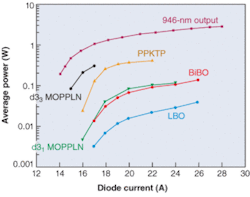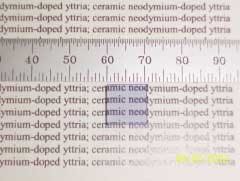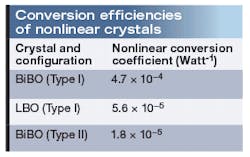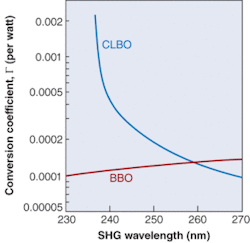New materials boost potential of 900-nm DPSS lasers
DAVE GERSTENBERGER, TOM TRAUTMANN, and ANDREW BROWN
Advances in nonlinear optical crystals have improved conversion efficiencies and expanded possible applications for diode-pumped solid-state lasers operating in the 900-nm region.
The second harmonics of solid-state 900-nm lasers show promise for a variety of applications requiring blue output, such as biomedical instrumentation, reprographics, and displays.1 The 900-nm fundamental and the third and fourth harmonics in the ultraviolet are also in demand for applications such as water-vapor light detection and ranging (lidar), ozone differential-absorption lidar (DIAL), and UV-resonance Raman spectroscopy. Recent developments in nonlinear optical materials have led to higher conversion efficiencies and higher blue and UV powers than have been commercially available for these applications, and are generating renewed interest in the harmonics of these 900-nm lasers.
Frequency doubling with MOPPLN and BiBO
Nonlinear crystals such as lithium borate (LBO) and barium borate (BBO) traditionally have been used for generating the second harmonics of diode-pumped solid-state (DPSS) lasers between 600 and 1300 nm, but conversion efficiencies (defined as the ratio of output power generated at the second harmonic to the input power at the fundamental wavelength) with these crystals for continuous-wave (CW) and low-peak-power pulsed lasers have typically been modest. Periodically poled materials and bismuth borate (BiBO) possess larger nonlinear coefficients than LBO and BBO. For CW lasers, the conversion efficiency varies as the square of the nonlinear coefficient.
Magnesium oxide-doped periodically poled lithium niobate (MOPPLN) and BiBO have recently been used to frequency double 900-nm DPSS lasers. The addition of 5% magnesium oxide (MgO) to lithium niobate during crystal growth significantly reduces photorefractive damage in this material, enabling its use for blue-light generation. In addition, MgO lowers the coercive voltage required to pole lithium niobate, enabling the production of MOPPLN crystals with thicknesses up to 5 mm. The geometry of a relatively thick crystal makes it much easier to use than a thin crystal. Thick crystals are less sensitive to alignment issues, and they are more rugged than their thinner counterparts. They are also easier to handle, polish, and coat.
To frequency double 946-nm light in MOPPLN using the large d33 nonlinear coefficient of the crystal, the domain period needs to be approximately 4.7 µm. MOPPLN crystals with this domain period and a thickness of 0.5 mm are commercially available. To frequency double 946-nm light using the smaller d31 coefficient, the domain period is approximately 18.9 µm; as a result, the relaxed domain period enables the production of 1-mm-thick crystals. Both of these materials have been used to frequency double Q-switched 946-nm Nd:YAG lasers.
Recently, BiBO has been commercially introduced. BiBO is less hydroscopic than other borate nonlinear crystals such as LBO, BBO, and cesium LBO (CLBO), with a larger nonlinear coefficient than LBO. Up to 2.8 W of 473-nm CW light has been generated using BiBO as the doubling crystal.2
For frequency doubling of a Q-switched 946-nm Nd:YAG laser, the performance of BiBO and MOPPLN was compared to LBO and periodically poled potassium titanyl phosphate (PPKTP; see Fig. 1). Each of the nonlinear crystals was 10‑mm long. The diode-pumped 946-nm laser provided up to 2.7-W average output power at 50 kHz, with 100-ns pulses and 18 W of diode pump power (diode current = 28 A). The output of the Nd:YAG laser was focused to a 50-µm spot for these experiments.
Conversion efficiencies of better than 30% can be achieved using d33 MOPPLN and PPKTP, even at low 946-nm powers. Stable operation of MOPPLN at the 300-mW 473-nm power level was observed for more than 100 hours. PPKTP was somewhat less efficient at lower powers; it suffered optical damage, and reliable operation was limited to 200-mW average 473-nm power levels. The performance for d31 MOPPLN and BiBO were similar; both were approximately five times more efficient than LBO.
Frequency tripling
The third harmonics of the 915- and 946-nm neodymium:yttrium oxide (Nd:Y2O3) laser lines (305 and 315 nm) provide an ideal combination of wavelengths for remote sensing of ozone. However, the growth temperature of Nd:Y2O3 is very high (2430°C) compared to Nd:YAG (1950°C), which complicates production and increases costs. Fortunately, recent advances in the production of ceramic laser materials such as ceramic Nd:YAG, ytterbium:yttrium oxide (Yb:Y2O3), ytterbium:scandium oxide (Yb:Sc2O3), and neodymium:lutetium oxide (Nd:Lu2O3) have led to the availability of large ceramic Nd:yttria crystals with high optical quality (see Fig. 2).As part of a Small Business Innovation Research (SBIR) program with NASA’s Langley Research Center (Langley, VA), Aculight recently demonstrated diode-pumped operation on each of the 900-nm lines of single-crystal Nd:Y2O3, as well as ceramic Nd:Y2O3. The experimental results are the basis for an ozone DIAL system based on the third harmonics of the 915- and 946-nm lines at 305 and 315 nm. Thus, it may be possible to build a more compact and reliable ozone lidar system using a single Nd:Y2O3 laser transmitter that is switched between the two DIAL wavelengths.
A common and efficient configuration for frequency tripling solid-state lasers operating at 1064 nm is intracavity tripling using Type II phase matching. In this Type II technique, the fundamental and second-harmonic wavelengths are polarized perpendicular to each other in the nonlinear crystal. This configuration is efficient and convenient because the polarizations of the fundamental wavelength and the third harmonic are parallel and can be easily separated using an intracavity prism or Brewster surface. Lithium borate is typically used as the frequency-tripling crystal at 1064 nm, but does not phase-match for Type II frequency tripling of either 915- or 946-nm lasers. Recently, however, Type II frequency tripling of a 946-nm neodymium:gadolinium yttrium aluminum garnet (Nd:GdYAG) laser using BiBO has been demonstrated (see table). Here, frequency tripling of 946-nm light using Type I phase matching in BiBO was approximately eight times more efficient than LBO. In addition, Type II frequency tripling in BiBO was demonstrated, although with approximately three times lower conversion efficiency than Type I LBO and comparable to the conversion efficiency for Type II frequency tripling of 1064‑nm light in LBO.Frequency quadrupling with CLBO
A number of potential applications exist for the fourth harmonic of 946-nm DPSS lasers. These include writing fiber Bragg gratings, and UV-resonance Raman spectroscopy for chemical and biological detection.3
Generating UV light below 300 nm is relatively inefficient because the conversion efficiency of nonlinear crystals for UV generation in this spectral range is low, and Poynting vector walk-off further reduces the conversion efficiency. Efficient conversion with these materials requires high-peak-power lasers or resonant optical cavities.
Recently, it was shown that phase matching for generating 236-nm light is noncritically phase-matched in CLBO, meaning that Poynting vector walk-off is eliminated.4 Consequently, focusing can be tight in the CLBO crystal, and conversion efficiency can be maximized. The nonlinear conversion coefficient for frequency doubling of CLBO and BBO as a function of second-harmonic wavelength illustrates the benefit of noncritical phase matching at 236 nm. At this point, CLBO is approximately 20 times more efficient than BBO (see Fig. 3).A 22% conversion efficiency from 473 to 236 nm was demonstrated using a frequency-doubled Q-switched 946-nm Nd:YAG laser with peak power of 119 W. To date, more than 150 mW of average 236-nm power has been generated.
The 236-nm UV wavelength provides advantages over other UV wavelengths such as the 266-nm fourth harmonic of 1064‑nm solid-state lasers for a number of applications. One important application is chemical and biological remote sensing using resonance Raman spectroscopy. This technique typically uses a 266-nm laser to detect and identify a variety of materials. However, 266-nm light induces fluorescence in tryptophan, an amino acid component of proteins found in many forms of bacteria. The fluorescence interferes with Raman signals, reducing the signal-to-noise ratio and, ultimately, detection sensitivity. Excitation with 236-nm light eliminates tryptophan fluorescence, enabling more widespread use of resonance Raman spectroscopy for detection of chemical and biological agents.
More to come
Historically, the lion’s share of the commercial DPSS laser business has been based on 1-µm lasers and their harmonics. But now that certain enabling laser materials and nonlinear optical crystals have become commercially available, laser systems based on 900-nm DPSS lasers and their harmonics are gaining more attention for critical applications in a number of industries, with promise of more to come in the future.
REFERENCES
1. L. Marshall, Laser Focus World 40, 79 (October 2004).
2. C. Czeranowsky, E. Heumann, and G. Huber, Optics Letters 28(3), 432 (March 15, 2003).
3. S. Asher, et al., Laser Focus World 33(7) 99 (July 1997).
4. D. C. Gerstenberger, T. M. Trautmann, and M. S. Bowers, Optics Letters 28, 1242 (July 15, 2003).
Dave Gerstenberger is a principal scientist, Tom Trautmann is a development engineer, and Andrew Brown is director of business development at Aculight, 11805 North Creek Parkway South, Suite 113, Bothell, WA 98011; e-mail: [email protected].



